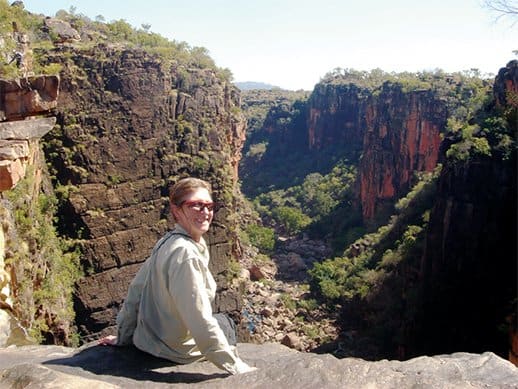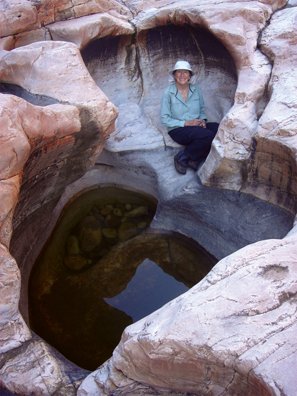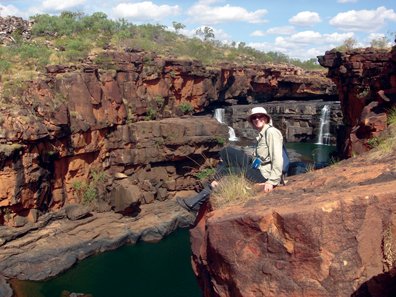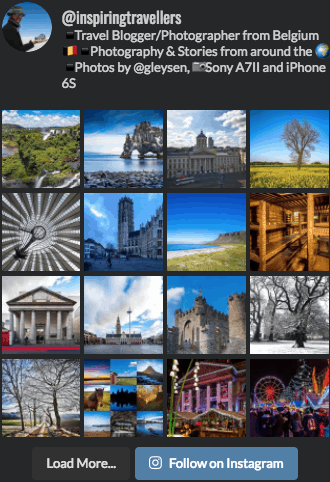You recently climbed Mount Kinabalu, which is the highest mountain in Borneo. What made you choose that destination?
A number of years ago I was showing some photographs of where I’d been in Australia, and there was a Malaysian guy who was quite impressed with these photographs of the Kimberley and he brought in some photographs of Mount Kinabalu. His was a climbing trip of it, which wasn’t walking, and they were just spectacular and amazing. I quite like rocks and I thought: I’ve got to go there.
Have you done a lot of mountain climbing in the past?
“Mountain climbing” might be a little bit of an exaggeration. Mountain climbing to me is serious and above 6,000 metres. You have to have technical skills. I’ve got no technical skills, but I’ve got a great affinity with rock. I love it. I like free climbing and I feel quite confident on it. Scrambling up a pretty steep slope doesn’t usually faze me – as a matter of fact I really like it. Predominantly I’m a bushwalker – that’s how I define myself. And along with the people who define themselves as bushwalkers there are people who like rocks and don’t like rocks. I’m one of the people who likes rocks. I have reasonable skills at it. Heights don’t worry me, a drop off doesn’t worry me. As long as I feel secure, I’m happy.
Mount Kinabalu is supposed to be very accessible for people who don’t have mountaineering skills and that is how it’s marketed. Would you say that’s a fair assessment?
Yeah, it is. Absolutely. As long as you’re aerobically fit and used to doing a continual ascent without having to rest.
You seem to prefer to go off the beaten track. As a traveller, is that your niche?
Kinabalu was enjoyable and I probably enjoyed it more than I expected to, but that’s not the experience that I go for. [There was] a line of people and some of these people were struggling on something that wasn’t really that difficult, and just the numbers there – that just doesn’t appeal to me. I prefer a place that’s more remote and pristine and less populated. You really get a feel for what the true natural environment is for the people who live in that area as opposed to just a traveller’s perspective.
What places have really fulfilled that for you?
The two trips in the Kimberley [in Western Australia] that I did were like that. The first one was 16 days and you just don’t see anyone. And the next one was five weeks and there wasn’t a track to be seen, there wasn’t a road to be seen, there was just no sign of any civilisation for that entire time. We had two food drops, which came in by helicopter. And that was our only contact with anyone other than the nine people that were in our group for five weeks. You don’t get that opportunity very often.
You navigated the entire trip yourselves?
It was truly exploratory. It was the guide who looked on the map and saw these river systems that topographically looked very interesting. There were these big sheer cliff lines and big rivers and gorges and then [he] designed a trip that incorporated those over the weeks.
Is that the first time you had done something that was so uncharted?
On that scale. I did a 16 day trip in Kakadu a few years ago, but that was a bit more regulated because you have to submit the plans to the Aboriginal governing body and they see what route you’re going to take, and they have to agree to it because they don’t want you walking in respected sites. They can challenge or decline your access to certain points. And that did happen there because they’ve got some sacred sites. So those three trips have been the most remote: Kakadu and the two in the Kimberley.
Do you ever travel and just go to the city?
I can and I do but I like it to be just that little bit different. Because in so much of the Western world everything is available, it has to be a culturally different place. The coffee might be different or what they have for breakfast might be different… In Peru, the fact that there are women with a little Primus cooking corn on the side of the road, and everyone just goes up and buys that and walks along munching that; I was really fascinated by that, for example. Just something really different.
Do you have any advice for people travelling off the beaten track or who want to do a trip like you did in the Kimberley?
Have very good skills if you’re really going off the track because it’s a very harsh environment…there’s no dialling 000 and expecting someone to come. There are sat[ellite] phones, which I think would be a necessity. Have a skilled leader, someone who can navigate. And you have to be resourceful and you have to take care. If you slipped and fell and broke your leg it was going to have dire consequences. You have to be fairly confident and strong in an environment like that and you don’t want to be clumsy….You have to be well prepared and fit and resilient because it’s quite a harsh environment. Particularly in the Kimberley; the hot sun is quite oppressive. You need to be safe and have a good leader who’s got good navigational skills
Where haven’t you gone that you’d like to?
I would like to go to some of what used to be the Eastern-bloc countries like Slovenia, because I’ve been told that they’re really nice and just amazing. And just go off the beaten track there. I also would like, at some stage, to do something in Pakistan.
I think we’re truly blessed in this country [Australia] that we’ve got so many isolated places that are totally uninhabited and you have the ability to go to them. There are countries on this earth that have huge populations and you can never really travel in those remote areas. That’s something to be treasured and it’s equally beneficial that few people like to do it; that means it’s not going to get too crowded or too popular. Because that always happens [with] off the beaten track places. Look at Nepal. It’s becoming more mainstream now to go to Nepal when once upon a time it was only people who were interested in walking. Interesting walks have become more mainstream, and by people whose expectations are a lot higher than what everyone else’s have been. That changes the landscape of the whole trip and it’s just not as interesting and culturally unique.
Elmore works as a nurse in Melbourne and is currently planning her next adventure in the Gammon Ranges in South Australia.
When you travel, do you seek out places that are “off the beaten track?” Where do you find your information about these remote or unique destinations?



